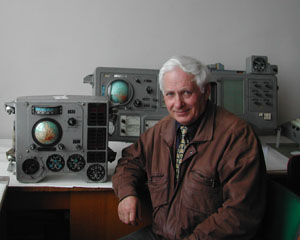|
The MIR space station consists of the core module ("the base
block") and five research modules. Crews are delivered to the
station by transport ships Soyuz-T (TM). The station provides an
environment for scientific and technological experiments and for certain
production processes. The functions of the crew are as follows:
- control the position of the station and its systems in order to
create conditions that are necessary and sufficient for life support
and for carrying out experiments and production;
- fulfill flight mission, that is, carry out experiments and
production.
This paper describes equipment designed for the first function:
information display systems (IDS) Pluton and Mirzam of the station core
module, and IDS Merkurii of the research modules, as well as IDS Neptun,
which serves the same function on the manned spacecraft Soyuz-T (TM). The
main IDS on the orbital stations Salyut of the Rocket-and-Space
Corporation Energia were Sirius-17K and Mirzam-17K. The manned
spacecraft Soyuz was equipped with the same type of IDS Sirius (in the
first period) and Mirzam (in the second). 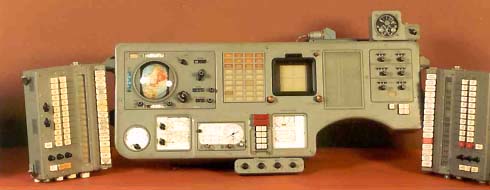
Figure
1. IDS Sirius: instrument board (center) and command-signal devices
(left and right) for control and monitoring of onboard systems. IDS
Sirius consists of two command-signal devices and an instrument board.
For the first time in the world, IDS Sirius implemented the following
features:
- selective control and monitoring systems with compression of
commands and information, based on command-signal devices with the
matrix method for selecting objects of control and monitoring;
- display of television and measurement information on a
multifunction screen, separately or in the combined mode;
- transmission to the Earth of the information displayed for the
cosmonaut on the multifunction indicator screen;
- programming-timing method of monitoring and control;
- new technological base and design of electroluminescent
multifunction signal indicators;
- finger controllers for spacecraft guidance; and others.
These IDS had been unique and had been successfully used in the
Soyuz-7K, Soyuz-Apollo, Salyut, and Almaz programs, and yet in the
design phase of the MIR space station and during the modernization of
the Soyuz spacecraft the goal was set to create new IDS. What were the
reasons for this decision? The objective reasons were the need to
provide interface with the onboard computing complex during distant and
close approach, mooring, docking, re-entry preparation, and descent on
the Soyuz spacecraft, and also a significant increase in the complexity
and volume of tasks carried out on the space station. The subjective
reason was the mismatch between the design of manual control panels of
the command-signal type and the demands of human engineering, which
emerged during ground tests and at the launch site. Such ground tests
included monitoring of execution of complex commands, i.e. commands that
could simultaneously turn on or off numerous devices. Operators were
asked to monitor if the commands were carried out correctly or
incorrectly. In order to do that, they had to constantly switch between
different display modes of the command-signal device and search for
correct or false signals, which took much time. Working with the
command-signal device also presented difficulties for cosmonauts when
they tried to monitor the execution of generalized commands. This
drawback was eliminated by the introduction of device status control
indicators. The principle of monitoring based on status change was first
developed and implemented in IDS created by the Specialized Experimental Design Bureau of Spacecraft
Technology for the ground experimental complex (NEK), and also in the
IDS Uran of the landing module of N1-L3. As a
result of modernization of control system, the following IDS were
created:
- IDS Neptun for Soyuz-T, which relies on information
support and software for the onboard computing complex;
- IDS Pluton.
IDS Mirzam of the MIR station is analogous to the IDS
Mirzam of the Salyut station. 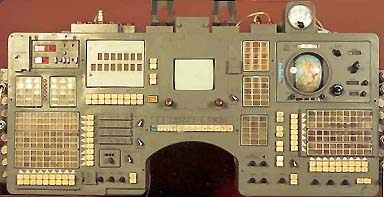
Figure
2. Cosmonauts' panel of the IDS Neptun for Soyuz-T. IDS
Pluton includes four functional subsystems:
- subsystem of manual control of the onboard control complex;
- subsystem of emergency and warning signaling;
- subsystem of parameter monitoring;
- EVA control panel.
The subsystem of manual control of the onboard control complex
consists of two panels: a signal monitoring panel (Figure 3) and a
command panel (Figure 4), which is spatially separated from the signal
field. This subsystem is implemented as a command-signal panel with
hierarchical selection of control objects and uncompressed
(multi-channel) display of signal information.
|
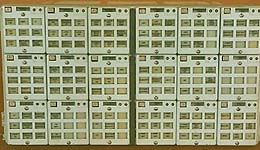
Figure 3. Signal monitoring panel |
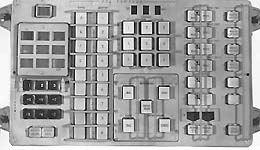
Figure 4. Command panel |
In order to increase the efficiency of operator work with IDS, the
dark screen mode and the actual status mode are implemented. The
introduction of these modes and the spatial separation of command and
signal fields are among the most significant achievements in the
development of IDS for large systems. The central post of the MIR
station has two such subsystems. The subsystem of emergency and
warning signaling consists of 3X3 signal screens with red, yellow, and
green signals. Red and yellow signals are accompanied by sound signals.
New signals are flashing.
|
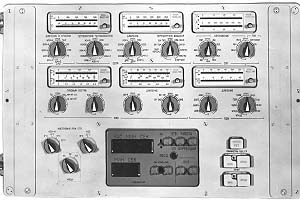
Figure 5. Parameter monitoring panel |
The subsystem of parameter monitoring serves to
monitor the most important parameters of onboard systems. It uses
the sequential/parallel method of information display. Devices
with light indication built by Vibrator factory in St. Petersburg
are used as indicators. |
The structure, functions, and working modes of the IDS Merkurii of
the MIR space station are analogous to the structure, functions, and
working modes of the IDS Pluton. For maintenance and repair of the IDS
installed on the MIR station, a spare part and instrument toolkit was
provided on board and on the ground. The actual reliability of the
systems proved higher than was expected, and the toolkit was practically
never used. The situation with the IDS Neptun of the Soyuz spacecraft
was different. The unique instruments created for this IDS in
cooperation among many enterprises, despite their effectiveness, proved
too expensive for industrial production. Some of the suppliers of spare
parts went out of business in the past 10 years, and the
Rocket-and-Space Corporation Energia and the Specialized Experimental Design Bureau of Spacecraft
Technology faced the difficult task of supplying panels for Soyuz-TM
spacecraft. This problem was solved in two steps. First, some panels
were reused. Second, old electroluminescent indicators were replaced
with compatible new models, based on light-emitting diode matrices and
digital indicators.
The main results of the development of IDS for the MIR
program are as follows:
1. For the first time in the world, in the development of automated
control systems for complex objects, the following problems were solved:
- design of command-signal panels with an uncompressed mode of
signal information display, with hierarchical selection of control
objects, and with spatial separation of information and control
fields;
- determination of the optimal structure of a display for the
proposed control procedure;
- implementation of a control mode based on device status change;
- implementation of a dark screen mode and an actual status mode;
- design of an onboard IDS based on mnemonic schemes using light-emitting
diodes.
2. The high efficiency of methods of IDS design and
testing, developed in manned cosmonautics, has been proven.
3. The use of the IDS Neptun instead of the IDS
Sirius-7K has confirmed the high adaptability of command-signal panels
to a change in control commands.
4. The Specialized Experimental Design Bureau of Spacecraft
Technology and the Rocket-and-Space Corporation Energia were
among the first in the history of cosmonautics to solve the problem of
reusing IDS hardware developed for the Soyuz-T (TM) program.
5. IDS using electroluminescent devices, light indication devices,
push-button switches, and other devices for display, switching, and
processing of information, developed for manned cosmonautics in
accordance with the RK-75 specification, have demonstrated excellent
economic, technological, and ergonomic parameters.
6. Research has shown that the reduction of safe life of the IDS
Neptun of the Soyuz-T spacecraft during complex ground tests at the
factory and at the launch site (68%) is significantly higher than during
an actual flight (8%). Display devices and control equipment on average
reduce their safe life by 0.05 to 12.4% during complex ground tests, and
by 0.027 to 2.1% during flight. This means that the design of IDS must
take into account the specificity of operator work during ground tests.
7. During the execution of long-term programs, an important practical
lesson was obtained, namely that partial modification of IDS is
expensive and inefficient.
Postscript
The following employees of the Specialized Experimental Design Bureau of Spacecraft
Technology made a big contribution to the development of IDS for the
Salyut and MIR space stations, and for Soyuz-7K, -A8, -T, and -TM
spacecraft: S.G. Darevskii (chief designer of the Bureau until 1973),
S.A. Borodin (chief designer since 1973), D.N. Lavrov, V.P. Konarev, N.A.
Oshchepkov, E.I. Bondarev, S.A. Pakhomov, G.N. Otreshko, G.F. Tiulenev,
R.K. Andrianov, S.A. Sadovnikov, A.D. Pochetov, V.P. Zubchenko, M.I.
Borisov, V.N. Maksimova, A.A. Khmelinskii, A.V. Belkov, L.P. Simanovskii,
A.G. Lebedev, and many others.
|
